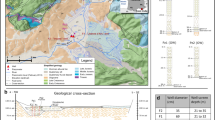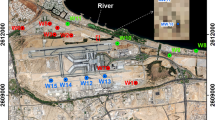Abstract
A pumping test conducted in an aquifer of large thickness is typically performed with partially penetrating wells. In this study, a novel, practicable method is proposed for the interpretation of drawdown data from a partially penetrating monitoring well drilled in a confined aquifer. The method is established on the assessment of the area below the curve passing through the measured drawdown versus time data points. The evaluated area can be matched with the identical area below the theoretical type curve to acquire the corresponding dimensionless time and drawdown variables, which ultimately yield the explored hydraulic conductivity and specific storage of the aquifer. The method eliminates the knotty and time consuming steps employed in the traditional curve matching procedure and proposes a simple solution algorithm with straightforward algebraic operations. The accuracy of the methodology was verified with hypothetical and real test cases. The attained results reveal the capability of the method in estimating the hydrogeological parameters at high accuracy with relatively little effort.





Similar content being viewed by others
References
Abramowitz M, Stegun, IA (1972) Handbook of mathematical functions. U.S. Department of Commerce, National Bureau of Standards, 1046 pp
Ataie-Ashtiani B, Shafei B, Rashidian-Dezfouli H, Mohamadzadeh M (2012) Capture zone of a partially penetrating well with skin effects in confined aquifers. Transp Porous Media 92(2):437–457
Avci BC, Sahin AU, Ciftci E (2011) Aquifer parameter estimation using an incremental area method. Hydrol Process 25(16):2584–2596
Barry DA, Parlange JY, Crapper M (1999) Approximation for the Hantush M-function. J Hydrol 221(1–2):91–96
Barua G, Bora SN (2010) Hydraulics of a partially penetrating well with skin zone in a confined aquifer. Adv Water Resour 33(12):1575–1587
Boonstra J (1992) Aquifer tests with partially penetrating wells: theory and practice. J Hydrol 137(1–4):165–179
Cassiani G, Kabala ZJ, Medina MA Jr (1999) Flowing partially penetrating well: solution to a mixed-type boundary value problem. Adv Water Resour 23(1):59–68
Chiu PY, Yeh HD, Yang SY (2007) A new solution for a partially penetrating constant-rate pumping well with a finite-thickness skin. Int J Numer Anal Methods Geomech 31(15):1659–1674
Fen CS, Yeh HD (2012) Effect of well radius on drawdown solutions obtained with Laplace transform and Green’s function. Water Resour Manag 26(2):377–390
Feng Q, Wen Z (2016) Non-Darcian flow to a partially penetrating well in a confined aquifer with a finite thickness skin. Hydrogeol J 24(5):1287–1296
Hantush MS (1961a) Drawdown around a partially-penetrating well. J Hydraul Div Proc ASCE 87(4):83–98
Hantush MS (1961b) Aquifer tests on partially-penetrating wells. J Hydraul Div Proc ASCE 87(5):171–195
Hantush MS (1964) Hydraulics of wells. In: Chow VT (ed) Advances in hydroscience. Academic, New York, pp 281–432
Kruseman GP, de Ridder NA (1994) Analysis and evaluation of pumping test data. (Second Edition) Publ. No. 47, International Institute for Land Reclamation and Improvement ILRI, Wageningen, The Netherlands, 377pp
Mamedov BA, Ekenoglu AS (2006) Evaluation of the Hantush’s M(a, b) function using binomial coefficients. Water Resour Res 42:W09502
Nespak-Ilaco (1985) Optimum well and well field design report. Panjnad-Abbasia salinity control and reclamation project. Pakistan Water and Power Devel. Auth., Lahore, 109 pp
Sahin AU, Ciftci E (2016a) An integration-based estimation approach for the determination of slug test parameters under various flow geometries. Arab J Geosci 9:639
Sahin AU, Ciftci E (2016b) An area matching process to estimate the hydraulic parameters using transient constant-head test data. Hydrol Res 47(5):919–931
Singh SK (2008) Approximation of M function for partially penetrating wells. J Irrig Drain Eng 134(6):861–863
Theis CV (1935) The relation between the lowering of the piezometric surface and the rate and duration of discharge of a well using groundwater storage. Trans Am Geophys Union 16:519–524
Trefry MG (1998) Analytical series expressions for Hantush’s M and S functions. Water Resour Res 34(4):909–913
Wen Z, Liu K, Zhan H (2014) Non-Darcian flow toward a larger-diameter partially penetrating well in a confined aquifer. Environ Earth Sci 72(11):4617–4625
Yang SY, Huang CS, Liu CH, Yeh HD (2014) Approximate solution for a transient hydraulic head distribution induced by a constant-head test at a partially penetrating well in a two-zone confined aquifer. J Hydraul Eng 140(7):04014030
Zlotnik VZ (1997) Effects of anisotropy on the capture zone of a partially penetrating well. Ground Water 35(5):842–847
Author information
Authors and Affiliations
Corresponding author
Ethics declarations
Conflict of Interest
The author declares no conflict of interest.
Additional information
Publisher’s Note
Springer Nature remains neutral with regard to jurisdictional claims in published maps and institutional affiliations.
Rights and permissions
About this article
Cite this article
Ciftci, E. A New Approach for Analyzing Drawdown Data from a Partially Penetrating Well. Water Resour Manage 33, 2727–2739 (2019). https://doi.org/10.1007/s11269-019-02246-3
Received:
Accepted:
Published:
Issue Date:
DOI: https://doi.org/10.1007/s11269-019-02246-3




